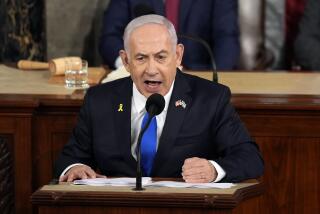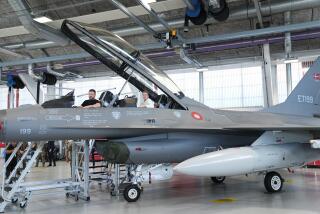F-35 Stealth Fighter May Finally Be Climbing Above Its Problems
Production of the long-delayed F-35 is finally ramping up. More than 3,000 planes will be built for the U.S. and 11 other countries.
- Share via
A rumble shakes the air as two British F-35 fighter jets take a low approach and circle a landing strip.
Nearby, a U.S. Air Force F-35 roars down another runway, only to decelerate rapidly as part of a test to see if cables correctly catch a hook on the back of the plane. Moments later, an Air Force F-35 taxis out and takes off, afterburner blazing, followed by a Danish F-16 that serves as a chase jet.
The mix of nationalities on display is a testament to the complexity of the most expensive weapons program ever.
But the buzz of increased test flight activity in the Mojave Desert also signals that production of the long-delayed F-35 — which was initially supposed to enter full-scale production in 2008 — is finally ramping up.
That increased rate of building, toward full production in 2019, is now rippling through more than 100 Southern California subcontractors that supply parts and software for the F-35’s builder, Lockheed Martin Corp.
Eventually, more than 3,000 planes will be built for the U.S. and 11 other countries, at a total projected cost of $379 billion, which includes inflation. The jet’s F135 engine, is built exclusively by Connecticut-based Pratt & Whitney.
There are 180 of the planes in services and Pratt expects to deliver 88 engines this year, up from 42 last year. Pratt expects to deliver 200 a year by 2020. The company assembles the engines in Middletown and West Palm Beach, Fla.
The engine has had its share of issues with, including an engine fire last year that temporarily halted the construction of the jets and federal auditors rated the reliability of the engine as “very poor” in a report.
“I’ve been on the program now for about 11 years,” said Don Kinard, senior technical fellow at Lockheed. “This is pretty exciting to finally get to the point where we’re increasing [the] rate.”
After years of delays and cost overruns, the program now seems to be on track.
“It looks like all the major hurdles are behind them,” said Richard Aboulafia, aviation analyst at the Teal Group, an aerospace and defense analysis firm. “And they’re running out of possibilities for major surprises.”
The problems began with the original concept of building a sort of flying Swiss Army knife.
Known as the Joint Strike Fighter, the F-35 was to be all but invisible to radar, fly faster than the speed of sound and incorporate advanced sensors, including a helmet that displays feeds from video cameras embedded in the plane so a pilot could look through the jet to target something on the ground.
The new fighter would replace four aircraft, with design variations to meet the unique requirements of the Air Force, Marine Corps and Navy.
For example, the F-35B model for the Marines can take off from short airfields and land vertically. To do so, its jet pipe swivels downward and a powerful downward-facing fan opens up behind the pilot.
The Navy variant has larger wings and hardier landing gear, to handle the stress of takeoffs and landings on aircraft carriers.
The most common model, with conventional takeoff and landing capabilities, is being built for the Air Force and other U.S. allies such as Israel and Denmark.
That complexity means that some parts, like the center fuselage produced by Northrop Grumman Corp., must be designed several ways. Depending on which variant is being produced, Northrop Grumman changes out its locating feature, a tool that holds parts in the right location for assembly. Robots and drill machines are also programmed differently.
Signing up partner nations to buy and help build the plane was seen as a way to spread the cost. But another cost-saving strategy -- allowing Lockheed to start building planes while development continued -- contributed to the production problems.
For instance, in 2014 an engine caught fire shortly before takeoff at Eglin Air Force Base in Florida, leading to a temporary grounding of the F-35 fleet. The fire was later attributed to excessive rubbing in a fan, and existing engines were retrofitted and new ones retooled.
The aircraft’s complex nerve center, composed of more than 8 million lines of code, had stability issues. A bug in earlier versions of the software caused it to shut off and “reboot,” according to written testimony from Frank Kendall, undersecretary of Defense for acquisition, technology and logistics, and Lt. Gen. Christopher Bogdan, program executive officer for F-35, before the Senate Armed Services Committee in April.
The latest version of the software that would give the planes full combat capability may still have shutdown issues. A recent report from Aviation Week said the development team at Edwards has seen glitches that required system reboots. Program officials told the publication it was normal to encounter challenges during developmental testing.
In April, an official with the Government Accountability Office said that while cost estimates have decreased since 2014, the program still faces “significant affordability challenges.”
The total cost of the program has more than doubled, and the military has repeatedly said the program was back on track before another problem derailed it.
In 2014, Lockheed Martin and its principal subcontractors Northrop Grumman and BAE Systems said they would invest $170 million over two years to reduce the cost of the fighter jet by investing in more efficient manufacturing processes.
Lockheed officials said that should help reduce the cost of the most common jet variant from almost $100 million per plane to about $85 million by 2019.
Building more jets will also drive down per-plane costs. Lockheed plans to increase production from four jets a month in its facility in Fort Worth to up to 17 a month by 2019. The company has delivered more than 170 operational jets so far.
Though the production ramp-up seems to be going “reasonably well,” producing 150 aircraft a year will be a whole other challenge, Aboulafia said.
“That involves significant output increase by the supply chain,” he said. “Probably not a major risk, but definitely something to reckon with.”
Courant staff contributed to this report.
More to Read
Inside the business of entertainment
The Wide Shot brings you news, analysis and insights on everything from streaming wars to production — and what it all means for the future.
You may occasionally receive promotional content from the Los Angeles Times.











